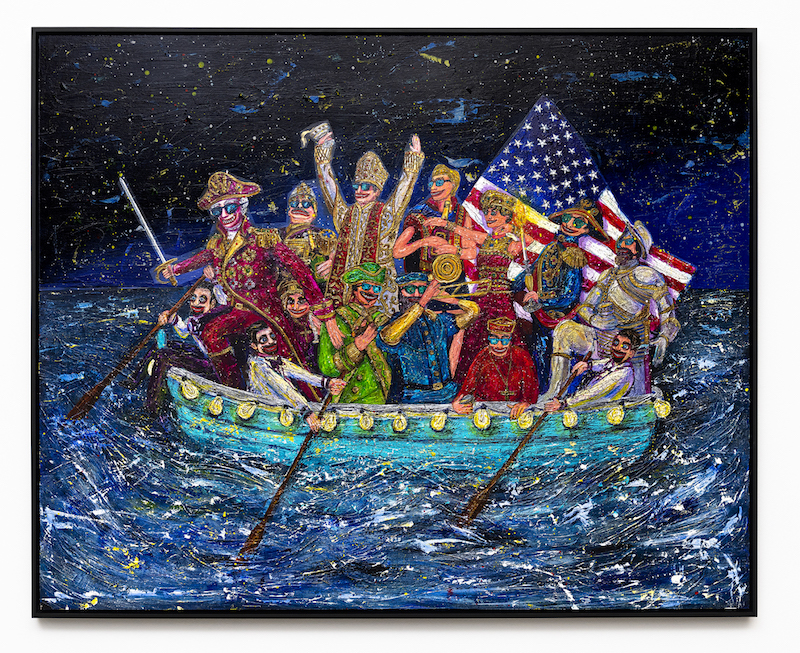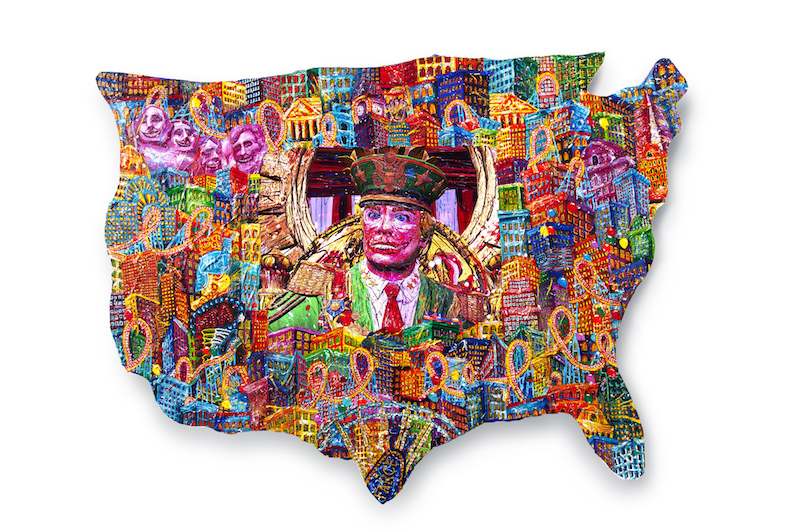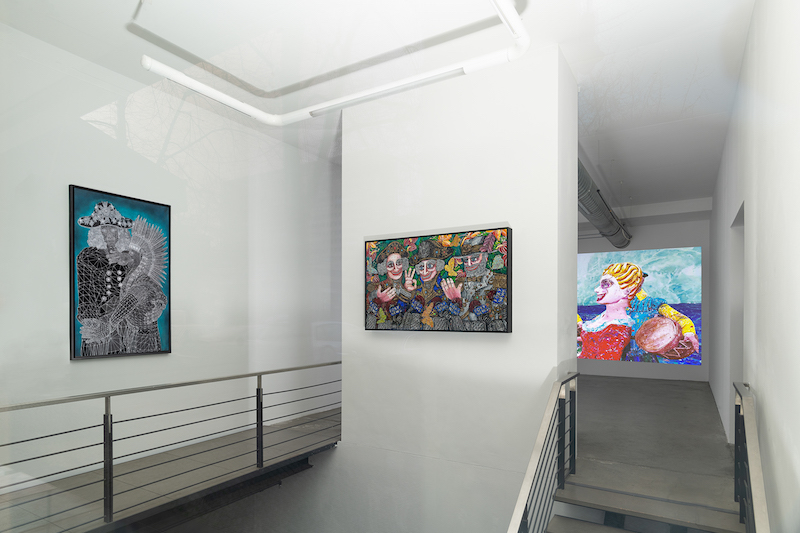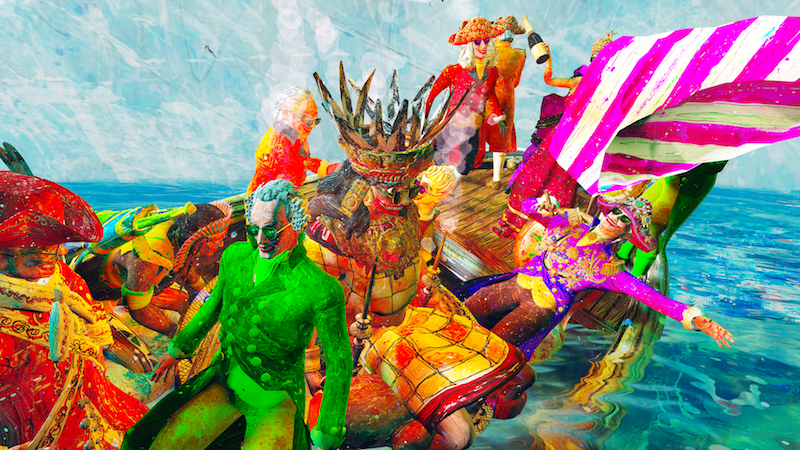by Nadia Egan // June 16, 2023
Federico Solmi’s works are rich in social and political satire. Taking inspiration from his disillusionment with the myths that surround and define American society, his practice takes on a form of social commentary that intends to stimulate conversation and reconfigure the historical narratives that have held until now. Bright colors, puppet-like characters and images culled from video games and pop culture combine to create carnivalesque scenes that portray his own vision of an absurd society.
On view at Guardini Galerie Berlin is Solmi’s latest series of eccentric landscapes. Through a range of media—from painting to video installation, drawing to virtual reality—his surreal caricatures of mostly world leaders and politicians act out scenes in erratic ways, suggesting drunkenness and unpredictability. With a fitting title, ‘The Drunken Boat’ questions American history and politics, saturating them in dark humor and mockery.

Federico Solmi: ‘The Drunken Boat,’ 2023, acrylic, gold leaf, silver leaf, pencil, ink, mixed media on wood panel, 122 x 152 x 5 cm // Courtesy of the artist and Kornfeld Galerie Berlin
Nadia Egan: What have been the biggest driving forces behind your use of satire?
Federico Solmi: My interest in social commentary is what motivates me and gets me out of bed in the morning. It has always been a driving force of mine to use art not with the goal of creating a beautiful, sellable object, but rather to use art as a weapon to denounce social injustices, to criticize political abuse and to ridicule propaganda and false myth-making. I spent the past 10 years of my career creating gallery and museum exhibitions influenced by great books, such as Howard Zinn’s ‘A People’s History of the United States’, Eduardo Galeano’s ‘Open Veins of Latin America’ and James Loewen’s ‘Lies My Teacher Told Me.’ This kind of literature inspired me to focus my work on exposing the myths and lies of the ethnocentric American historical narrative, on denouncing the tragedy of colonialism and on underlining the catastrophic consequences these events had on native populations.

Federico Solmi: ‘The Machiavellian Ones,’ 2019, acrylic, gold leaf on shaped plexiglass, LCD screen, video, 73,5 x 56 x 7,5 cm // Courtesy of the artist and Kornfeld Galerie Berlin
NE: How does this influence spill over into your current exhibition ‘The Drunken Boat’?
FS: ‘The Drunken Boat’—the title of a famous poem by Arthur Rimbaud—has haunted me for decades and is always coming back to me. The poem is written in the first person from the point of view of a boat adrift, after all of its passengers have been murdered. The description of the vessel’s erratic course, its assault by storms and the vast wastelands of the ocean reflect the torment of the poet’s soul.
A few months ago, while I was in my Brooklyn studio, I was inspired to start a new painting intended to serve as a metaphor and critique for the current state of political tension in America—a painting that would revolve around its own misleading historical narrative. One morning, I took my brushes and began painting a small boat filled with various bizarrely dressed political, military and religious leaders, such as George Washington, Benjamin Franklin, Thomas Jefferson, Hernan Cortez, Christopher Columbus and a Cardinal, among others. These protagonists, despite being lost in a tumultuous ocean, are happily dancing, drinking and flirting. Similar to the Rimbaud poem, I recognize the integrity of American history to be like a raft struggling through stormy waters, fighting to stay afloat. Thus, I titled first the painting, and then the exhibition, ‘The Drunken Boat.’
This painting along with the other works included in the exhibition operate as a collection of absurd short stories and vignettes meant to engage the audience in a reconfiguring of the already fallible American historical narrative. I hope the exhibition raises questions and sparks conversations regarding nationalism, colonialism and the Western canon.

Federico Solmi: ‘The Drunken Boat,’ 2023, installation view at Guardini Berlin // Courtesy of the artist an Guardini Galerie Berlin
NE: You utilize a variety of media in your exhibitions, including a unique combination of animation video derived directly from your paintings. What led you to start using this hybrid medium?
FS: A turning point occurred in 2003 when I created my first video animation, in which I combined, for the first time, gaming and digital technology with handmade drawings and paintings. I was eager to find a unique way to express myself and was conflicted between my interest in new technologies and new forms of expression, and my deep admiration of art history and tradition. Luckily, I had the intuition to organically blend these two distinguished worlds of the physical and the virtual.
One of the aspects that I am most proud of about the Guardini exhibition in Berlin is the fact that the public can fully experience the continuous dialogue between the digital and virtual worlds of my video animations and virtual reality experiences, and the more traditional media, such as the paintings and drawings which represent the foundation of my artistic research. The interplay between the physical and digital has always been an important characteristic and a driving force of my artistic practice.

Federico Solmi: ‘The Plastered Fathers,’ 2020, acrylic, gold leaf on shaped plexiglass, LED screen, video loop, 91 x 61 x 10 cm // Courtesy of the artist and Kornfeld Galerie Berlin
NE: It’s incredibly interesting to see one of the most traditional forms of art, painting, used alongside one of the most contemporary, virtual reality. What do you feel utilizing virtual reality does for the exhibition?
FS: I consider the virtual reality experience to be one of the most important pieces in the exhibition. It feels like a point of arrival after experiencing the complete collection of works in the show, and conveys without ambiguity the complexity, commitment and ambition behind my artistic practice. Technically speaking, there is no media other than VR that can bring the public inside the inner world of the artist. It is like living inside an artist’s painting, but even better because the aspect of interaction allows the viewer to make their own choices. By being given these choices, the viewer is called to complete the artworks from within the world of the artist. For me, it is just amazing to watch people’s reactions once they have the headset on–it’s really a spectacle!
Exhibition Info
Guardini Galerie
Federico Solmi: ‘The Drunken Boat’
Exhibition: Apr. 22-June 23, 2023
guardini.de
Askanischer Pl. 4, 10963 Berlin, click here for map




















